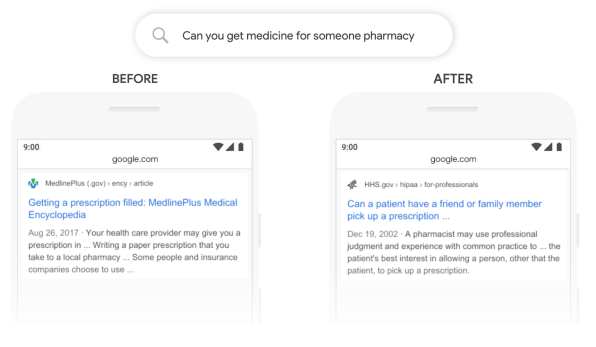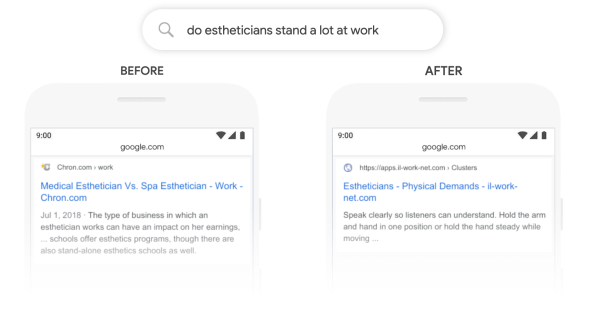Google just got better at understanding your trickiest searches
A new machine learning algorithm is helping Google tell which words in queries matter most – and how they relate to each other.

For Google’s namesake search engine, delivering the right results is about understanding what people are asking for. And understanding that involves zeroing in on the meaningful keywords in a search query and ignoring the rest. Words like “a” and “the,” for instance, can generally be safely ignored.
The problem is that there are lots of searches where it’s difficult for even a search engine as smart as Google to know how the words relate to each other and which ones matter. One example the company provides: If a user searches for “can you get medicine for someone pharmacy,” the “someone” is absolutely critical, since it’s shorthand for “someone other than myself.” A person would likely infer that that; a traditional search algorithm, not so much.
But now Google is rolling out an update to its English-language search engine designed to give it a deeper understanding of such subtle queries, which will let it deliver more relevant results. For the above search, results are now topped with a “featured snippet” involving the specific issue of picking up another person’s prescription. (Previously, the snippet involved prescriptions but failed to address the specific gist of the query.)
I attended a press preview at Google headquarters earlier this week, where some of company’s search executives showed examples of the new algorithm’s improved results and explained the new technology that went into them. And they set the bar high for expectations; VP of search Pandu Nayak called them “the single biggest change we’ve had in the last five years and perhaps one of the biggest since the beginning of the company.”

BERT AT WORK
Under the service, the new improvements leverage a technology developed at Google called BERT, which stands for Bidirectional Encoder Representations from Transformers. We non-AI scientists don’t have to worry about what encoders, representations, and transformers are. But the gist of the idea is that BERT trains machine language algorithms by feeding them chunks of text that have some of the words removed. The algorithm’s challenge is to guess the missing words—which turns out to be a game that computers are good at playing, and an effective way to efficiently train an algorithm to understand text. From a comprehension standpoint, it helps “turn keyword-ese into language,” said Google search chief Ben Gomes.
“The more text, the better the understanding,” said Google senior VP of research Jeff Dean—and fortunately, there’s no shortage of written material out there that Google can pour into BERT. (And oh, the “Bidirectional” part of the acronym references the fact that this technique moves away from the more conventional practice of analyzing text a word at a time from left to right.)
Using supercomputers it designed itself to train machine learning models, Google is applying BERT to give its search algorithm a deeper understanding of search queries and web pages that contain relevant information. Other tech companies have embraced BERT and are using their own variants for a variety of purposes: Facebook, for instance, is using a version called RoBERTa in chatbot research. But these new Google search tweaks are an early instance of BERT coming out of the lab and improving one of the world’s most widely used services.
The new BERT training is only one of an array of elements that Google calls upon to choose results for any given search; the company says that it will come into play in around 1 out of 10 searches. But that 10% should include some of the ones that were most likely to stump Google in the past, such as “How old was Taylor Swift when Kanye went onstage?” and “Do estheticians stand a lot at work?”
Under the service, the new improvements leverage a technology developed at Google called BERT, which stands for Bidirectional Encoder Representations from Transformers. We non-AI scientists don’t have to worry about what encoders, representations, and transformers are. But the gist of the idea is that BERT trains machine language algorithms by feeding them chunks of text that have some of the words removed. The algorithm’s challenge is to guess the missing words—which turns out to be a game that computers are good at playing, and an effective way to efficiently train an algorithm to understand text. From a comprehension standpoint, it helps “turn keyword-ese into language,” said Google search chief Ben Gomes.
“The more text, the better the understanding,” said Google senior VP of research Jeff Dean—and fortunately, there’s no shortage of written material out there that Google can pour into BERT. (And oh, the “Bidirectional” part of the acronym references the fact that this technique moves away from the more conventional practice of analyzing text a word at a time from left to right.)
Using supercomputers it designed itself to train machine learning models, Google is applying BERT to give its search algorithm a deeper understanding of search queries and web pages that contain relevant information. Other tech companies have embraced BERT and are using their own variants for a variety of purposes: Facebook, for instance, is using a version called RoBERTa in chatbot research. But these new Google search tweaks are an early instance of BERT coming out of the lab and improving one of the world’s most widely used services.
The new BERT training is only one of an array of elements that Google calls upon to choose results for any given search; the company says that it will come into play in around 1 out of 10 searches. But that 10% should include some of the ones that were most likely to stump Google in the past, such as “How old was Taylor Swift when Kanye went onstage?” and “Do estheticians stand a lot at work?”.

In the end, BERT probably won’t have as obvious an impact on results as past Google milestones such as universal search and the knowledge graph, both of which fundamentally revised the presentation of search results in ways you couldn’t help but notice. With the addition of BERT, results still look the same; if BERT makes them better, you’ll benefit—but you’ll never know that they would have been inferior in its absence.
And even then, Nayak cheerfully acknowledges that there are instances when the BERT-infused search results are worse than the old ones. At the press event, he showed a sample: When asked “What state is south of Nebraska?” the BERT result involved the neighborhood of South Nebraska in Tampa, Florida, and was not just less relevant than its non-BERT predecessor but downright useless. But Google’s testing shows such instances are rare enough that using BERT provides a clear overall advantage, which should increase as the company tweaks the technology over time.
“BERT is not like some magic bullet that solves all problems, but it does solve a lot of problem areas,” said Nayak. “There’s still more work to do.”
By: HARRY MCCRACKEN
Source: https://www.fastcompany.com/90422132/google-just-got-better-at-understanding-your-trickiest-searches
More From Blog

August 8, 2024
Data-Driven Product Development: Strategy To Drive More Sales
As a business owner, you want your products or services to be well-received upon launch. The most effective way to create a product that satisfies a broad range of customers is to gain insights into their needs and behaviors from the outset. The key lies in data-driven product development, a strategy that many companies have […]

August 8, 2024
7 Steps To Establish A Data-Driven Governance Program
While data-driven approaches significantly benefit organizations in various ways, failure to govern the huge data sets will hurt your business even more. Effective data management also ensures data quality and security. That’s why there is an increasingly high demand for data-driven governance programs. Continue reading for a detailed guide! What Is Data-Driven Governance? Surprisingly, many […]

August 8, 2024
Data-Driven Business Transformation: 7 Steps To Follow
Data empowers businesses to make well-informed decisions in different departments, like marketing, human resources, finance, and more. As a business owner, you should also employ data-driven approaches to skyrocket productivity and efficiency. If you are still new to this concept, scroll down for an in-depth guide on data-driven business transformation. What Does A Data-Driven Business […]

August 8, 2024
Data-Driven Security: Transforming Protection Through Analytics
Cybersecurity was once an afterthought for most organizations. But in today’s digital landscape, it has become mission-critical. With this transformation has also come a shift in how security decisions are made. Rather than relying solely on intuition and tradition, leading organizations are embracing data-driven strategies. By using metrics and insights around threats, vulnerabilities, and more, […]

August 8, 2024
Differences Between Data Science and Computer Science
Data Science and Computer Science are distinct fields overlapping in certain areas but have different focuses and objectives. The article below will help you clearly understand the differences and the close connection between the two fields. What is Data Science? Data Science is an interdisciplinary field that combines scientific methods, processes, algorithms, and systems to […]

August 8, 2024
How Real-Time Data Analysis Empowers Your Business
In today’s fast-paced business landscape, the ability to quickly make data-driven decisions has become a key differentiator for success. Real-time data analysis, the process of analyzing data as soon as it’s generated, has emerged as a powerful tool to empower business across industries. By leveraging real-time data analysis, organizations can gain timely and actionable insights, […]

